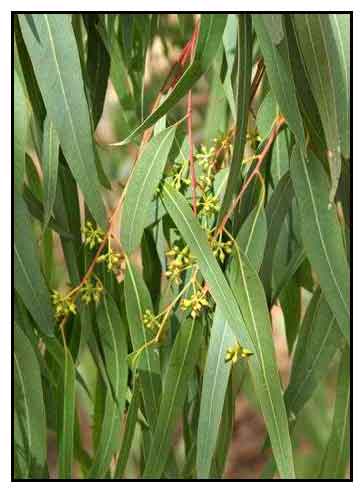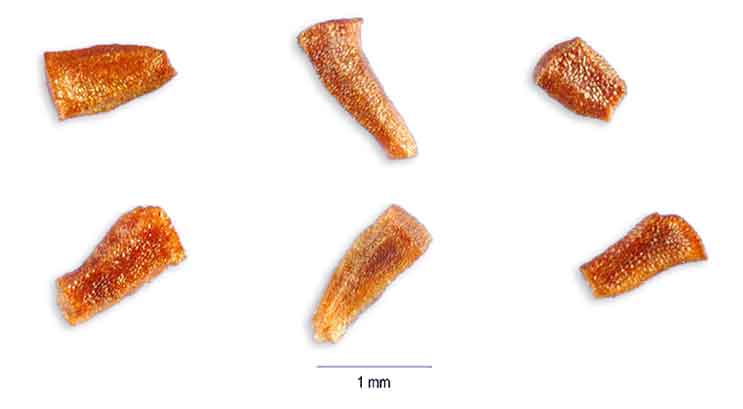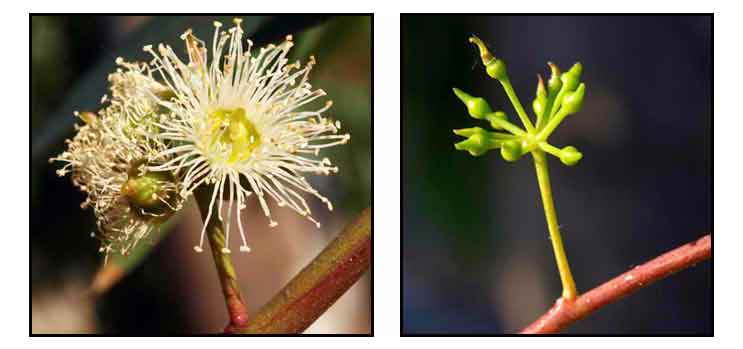 Gen info Gen info
- Th- Eucalyptus is a genus of about 800 species of flowering trees, shrubs or mallees in the myrtle family, Myrtaceae. Along with several other genera in the tribe Eucalypteae, including Corymbia, they are commonly known as Eucalyps. (30)
- Most species of Eucalyptus are native to Australia,
and every state or territory has representative species. About three quarters of Australian forests are eucalypt forests. (30)
- The species epithet 'camaldulensis' refers to a private garden (L'Hortus Camaldulensis di Napoli) near the Camaldoli monastery in Naples, where Frederick Dehnhardt was the chief gardener. and who first formally described E. camaldulensis. (29)
Botany
Eucalyptus camaldulensis is a tree growing 15 to 25 meters or taller, with an ash-colored, smooth, and exfoliating bark. Leaves are deciduous, alternate, lanceolate, acuminate, light green and thin. Inflorescences are axillary, simple, umbels are 5 to 11-flowered; peduncle is 1 to 1.5 centimeters, slender and terete. Flower buds are ovoid, 5 to 8 millimeters. Hypanthium is semiglobose, about 3 millimeters; stipes are 3 to 12 millimeters. Flowers are in umbels. Capsule is subglobose, 5 to 6 millimeters in diameter, disk broad, valves 3 to 5, exserted from the hypanthium.
Distribution
- Recently introduced to the Philippines.
- Native to Australia where it is widespread.
- Cultivated in China and Taiwan.
- Exotic in Bangladesh, Brunei, Cambodia, Indonesia, Myanmar.
Constituents
- Phytochemical screening yielded saponin, saponin glycosides, steroid, cardiac glycoside, tannins, volatile oils, phenols, and balsam (gum).
- Study yielded tannins, saponins and cardenolides.
- Study of leaf essential oil from different localities showed an oil yield from 0.63% up to 1.59%. On GC-MS analysis, monoterpene hydrocarbons were a major class of compounds. Dominant compounds were p-cymene (17.38-28.60%), ß-phellandrene (12.35-14.47%), and ß-pinene (0.94-11.48%). Second largest group was oxygenated monoterpenes with cryptone (4.97-7.25%) and terpinene-4-ol (2.75-4.21%) as predominant.
(14)
- Study of volatile oils from different fruit samples in Turkey
yielded 46, 54, 55, and 59 components. Main compounds were: aromadendrene (6.45-15.02%), eucalyptol (0.17-12.61%), γ-gurjunene (8.40-10.08%), terpinolen (1.98-8.39%), spathulenol (1.42-8.34%), α-pinene (0.85-6.81%), ledene (0.94-6.72%), and longifonene (0.07-6.22%). (15)
- Study on leaves of EC var. obstusa yielded a new triterpenoid camldulin (3ß-formyloxyurs-11-en-28,13ß-olide) (1) along with ursolic acid lactone acetate (2), ursolic acid lactone (3), betulinic acid (4) and ß-sitosterol 3-O-ß-D-glucopyranoside (5). (see study below) (19)
- Aqueous acetone leaf extract yielded 56 compounds including ellagitannins, flavonoids, phloroglucinol derivatives and galloyl esters. (see study below) (20)
- Phytochemical analysis of various extracts of leaves (petroleum ether, chloroform, ethanol, and water extracts)
showed the presence of tannins, sterol, triterpenoids, saponins, flavonoids, and phenolic compounds, with absence of alkaloids, anthraquinone glycoside, and cyanogenic glycoside. (22)
• GC-MS study of leaves, stems, and immature flowers yielded essential oil representing 1.40, 0.57, and 0.46% dw, respectively. Fifteen major compounds were identified representing 98.8, 97.5, abd 99.5% of the compounds in leaves, stems, and immature flowers. Monoterpenes hydrocarbons were predominant in the three samples. The flower oil was highest in oxygenated monoterpenes. Most abundant compounds in the three EO were y-terpinene as the principal oil component (57.4-72.5%) followed by o-cymene (14.6-26.3%) and terpinen-4-ol (6.6-16.2%). (see study below) (25)
 Properties Properties
- Antibacterial, vulnerary.
- Essential oil considered anti-tubercular.
- Studies have shown antimicrobial, gastroprotective, cytotoxic, anti-dermatophytic, antioxidant properties.
Parts used
Leaves, oils.
Uses
Folkloric
- No reported folkloric medicinal use in the Philippines.
- In Nigeria, decoction of leaves used to treat gastrointestinal disorders.
- Decoction of leaves used for sore throat and other bacterial infections of the respiratory and urinary tracts.
- Poultice of leaves applied over wounds; used for catarrh and nasal congestion.
- Essential oils used for treatment of lung diseases and tuberculosis.
- Volatile oils used
as expectorant and cough stimulant.
Others
- Apiculture: Major source of honey, capable of producing heavy yields of nectar. (8)
- Fuel: Suitable for use in industrial brick kilns. Makes a good charcoal. (8)
- Timber: Wood known for good strength and durability; suitable for many structural applications such as poles, posts, floorings, sleepers, and heavy construction. (8) Hallmark of river red gum timber is the distinctive red color. Heartwood is red to reddish brown with some coarseness in texture, with the grain commonly interlocked with frequent gum veins. The timber's charm is best showcased in furniture, with its spectacular deep red color and the typical fiddle-back figure making each piece unique. (31)
- Dye: Bole yields a gum that can be used as a dye. (8)
- Essential Oil: Rich in 1,8-cineole leaf oil with potential as commercial source of medicinal-grade eucalyptus oil. (8)

Studies
• Antimicrobial:
Methanolic extract of leaves of E. camaldulensis and Terminalia catappa were evaluated for in vitro microbial activities. Both inhibited the growth of Bacillus subtilis and Staphylococcus aureus, with no inhibitory activity on P. aeruginosa, S. typhi, and E. coli. Crude extracts of E. camaldulensis inhibited Candida albicans. (2)
• Antibacterial: In a study of antibacterial activity of leaf extracts, the methanol extract, dichlormethane fraction and methanol residue exhibited broad spectrum activity against all test organisms, viz., Klebsiella spp, S. typhi, Yersinia enterocolitica, P aeruginosa, S aureus and B subtilis. (3)
• Anti-H. Pylori: Study of E. camaldulensis and E. torelliana showed anti-H. pylori activities which were attributed to their chemical constituents. (4)
• Anti-tuberculosis: Study evaluated the anti-tubercular activities of extracts of E. camaldulensis and E. torelliana. The extracts inhibited the growth of MtbH37Rv. Results suggest the presence of anti-Mtb active compounds in the plants and presents a potential for the development of new and effective anti-Mtb drugs. (5)
• Antibacterial / Dental Caries / Plaque: In an in vitro study that examined dental biofilm production of Streptococcus mutans, the primary cause of dental caries, with various concentrations of Mentha spicata oil, Eucalyptus camaldulensis oil, and chlorhexidine, EO demonstrated a superior ability. In an in vivo 4-week study on plaque formation, EO at all concentrations had significant more inhibition compared to M. spicata and chlorhexidne.
• Acute Toxicity Study / Leaves: Study evaluated an ethanolic leaf extract of Eucalyptus camaldulensis for acute toxicity in a rat model. LD50 of the extract was ≥ 5000 mg/kbw. Extract did not show any obvious symptom or signs of toxicity, without alterations on hepatic and renal functions and hematologic profile. (9)
• Sub-Acute Hepatotoxicity Study / Leaves: Study evaluated an aqueous leaf extract of Eucalyptus camaldulensis on albino rats on varying doses from 250 mg to 1000 mg per kbw using hepatic biomarkers of ALT, AST, ALP, total protein and conjugated bilirubin. Results showed no significant difference (p<0.05) in all parameters suggesting no toxicological effect at administered doses. (21)
• Antimicrobial Effects / Biofilm Formation / Eucalyptus Oil: Study evaluated the antimicrobial effects of Mentha spicata and Eucalyptus camaldulensis essential oils and chlorhexidine against Streptococcus mutans and Streptococcus pyogenes, with focus on in vitro and in vivo biofilm formation. Antibacterial and in vivo biofilm preventive efficacies of all concentrations of Eucalyptus oil were significantly (p<0.001) higher than that of M. spicata oil and chlorhexidine. Results suggest E. camaldulensis and M. spicata significantly retard biofilm formation that can contribute to the development of novel anticaries treatments. (10)
• Antimicrobial / Leaves: Study evaluated the antimicrobial effects of aqueous and alcoholic extracts of E. camaldulensis leaves against some important food pathogen. Results showed Eucalyptus leaf extract has considerable in vitro antimicrobial activity over studied strains. (11) Methanolic extracts of leaves of Eucalyptus camaldulensis and Terminalia catappa were studies for in vitro antimicrobial activities. E. camaldulensis inhibited the growth of B. subtilis and S. aureus. Crude extracts of EC inhibited Candida albicans. (15)
• Cytotoxicity on K562 Human Chronic Myelogenous Leukemia Cells / Leaves: Study evaluated the cytotoxic effects of ethanolic extract of E. camaldulensis leaves on chronic myeloid leukemia cells K562. Results showed leaf extract compounds showed time dependent and dose dependent effects of K562 cells. Extract also has efficient antioxidant compounds with potential benefit in the treatment of cancer by inhibiting free radicals or as inhibitor of tumor cell growth. (12)
• Anti-Dermatophytic / Leaves: Study evaluated the in vitro antifungal activities of E. camaldulensis against Microsporum canis, M. gypseum, Trichophyton rubrum, T. schoenleinii, T. mentagrophytes and Epidermophyton flocossum. Results showed antifungal activity against all the dermatophytes tested with MIC values ranging from 0.4 to 1.6 mg/mL. Minimum fungicidal concentration (MFC) of the extracts ranged from 0.8 to 6.4 mg/mL. (13)
• Antibacterial / Leaves: Study of methanol extract, dichlormethane fraction and methanol residue of leaves of E. camaldulensis showed broad spectrum activity against all test organisms i.e., Klebsiella spp, Salmonella typhi, Yersinia enterocolitica, Pseudomonas aeruginosa, Staphylococcus aureus and Bacillus subtilis. (16)
• Dyeing Studies: Silk fabric dyed with Eucalyptus leaf extract, quercetin, rutin, and tannin using the pad-batch method showed higher color strength than those dyed with pad-dry technique. Results also showed good results with color fastness to washing. Application of natural dyes to silk fabric can be considered an effective eco-option. (18)
• Spasmolytic Constituents / Leaves: Study on leaves of E. camaldulensis var. obtusa yielded a new triterpenoid camldulin (3ß-formyloxyurs-11-en-28,13ß-olide) (1) along with ursolic acid lactone acetate (2), ursolic acid lactone (3), betulinic acid (4) and ß-sitosterol 3-O-ß-D-glucopyranoside (5). Compounds 1-3 were tested for spasmolytic activity and were found to possess calcium antagonist activity. (19)
• Antioxidant / Cytotoxic / Leaves: Study evaluated an acetone leaf extract yielded 56 compounds including ellagitannins, flavonoids, phloroglucinol derivatives and galloyl esters. Most of the fractions showed strong antioxidant activity on DPPH, hydroxyl radical, and superoxide anion radical scavenging assays. The aqueous acetone extract showed cytotoxic activity, reducing viability of all cell lines in a dose-dependent manner, with more activity against MCF-7 ad HCT-116 cell lines. (20)
• Antibacterial / Essential Oil / Leaves: Study of crude oil of EC leaves for in vitro antimicrobial activities against two clinical bacteria showed zones of inhibition of 10-31 mm and 10-26 mm respectively for E. coli and S. aureus. Results suggest potential application in the food and pharmaceutical industry. (23)
• Antimicrobial Properties: Active ingredients of the plants are primarily alkaloids, flavonoids, pigments, phenolics, terpenes, starches, steroids, and essential oils. Recent studies have shown antimicrobial effects against bacterial, fungal, parasitic and viral agents. Study revealed the effects of E. camaldulensis against S. aureus, E. coli, P. aeruginosa, Acinetobacter baumannii, S. pyogenes, P. vulgaris, S. typhi, Shigella spp., Candida albicans, C. parapsilosis, Anopheles stephensi, Trichomonas vaginalis, Coxsackie and poliovirus, among many others. (24)
• Essential Oil / Cytotoxicity / Leaves, Stems, Immature Flowers: Study evaluated the cytotoxicity and essential oil composition of E. camaldulensis leaves, stems, and immature flowers. GC-MS study yielded essential oil representing 1.40, 0.57, and 0.46% dw, respectively. Fifteen major compounds were identified representing 98.8, 97.5, and 99.5% of the compounds in leaves, stems, and immature flowers. Monoterpenes hydrocarbons were predominant in the three samples. The flower oil was highest in oxygenated monoterpenes. Most abundant compounds in the three EO were y-terpinene as the principal oil component (57.4-72.5%) followed by o-cymene (14.6-26.3%) and terpinen-4-ol (6.6-16.2%). Leaf EO demonstrated cytotoxic activity in three tested cancer cell lines i.e., WEHI-3 (most sensitive), HT-29, and HL-60. The main component f the oil, y-terpinene, showed a weak cytotoxic activity against the tested cancer cell lines. (25)
• Antiviral / Antimicrobial / Schistosomicidal / Essential Oil: Study evaluated the anitiviral, antimicrobial, and schistosomicidal effects of E. camaldulensis leaf essential oil. Rotavirus Wa strain, Coxsackie virus B4, Herpes virus type-1 were affected with percentage reduction of 50, 53.3 and 90^ reduction, respectively, with no effect on adenovirus type 7. The EO showed significant effects against gram-positive and gram-negative bacteria with inhibition zones from 9.3 to 12.5 mm. There was 31% inhibition on yeast and 10% inhibition on fungi. The IC90 of EO produced severe damage on schistosoma worm's typography. (26)
• Antiviral / Herpes Virus / Leaves: Study evaluated the antiviral activity of ethanol leaves extract of E. camaldulensis on different herpes viruses om Vero cells. Results showed significant antiviral activity against all tested viruses i.e., herpes simplex viruses HSV-1 and HSV-2, Varicella zoster virus (VZV). The 80%-MeOH fraction showed highest activity with 50% inhibitory concentration (IC50) of 0.1, o.3, and 1 µg/ml against HSV1, HSV2, and VZV, respectively. A synergistic antiviral effect was observed with a combination of acyclovir and the fraction. (27)
• Antiulcer / Gastroprotective / Leaves: Study evaluated the ulcer-healing promoting effect of a methanol extracts of E. camaldulensis and E. torelliana leaves on acetic acid induced ulcer in rat. Phytochemical screening yielded tannins, saponins, and cardenolides in both plants with the addition of anthraquinones in E. torelliana. Results showed a decrease in diameter of ulcer size of 46.67% and 58.33%, respectively. (28)
Availability
- Wild-crafted.
|


 Gen info
Gen info Properties
Properties


